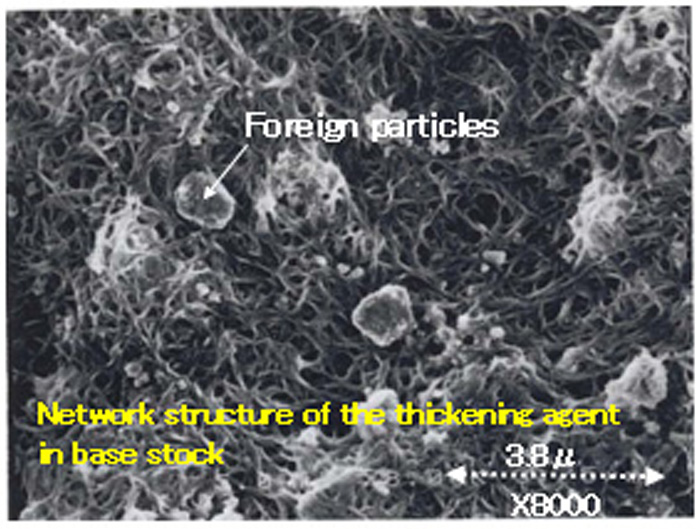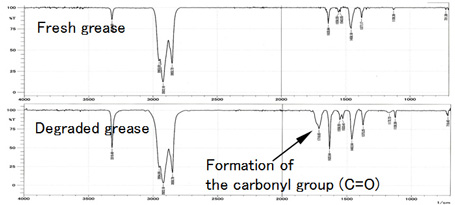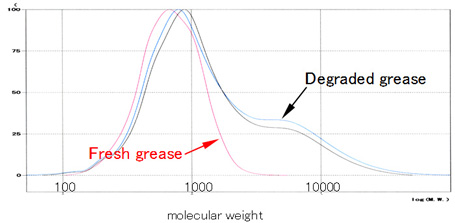Study and Analysis of a Root Cause of Failure
in Resin Composite Materials
Investigation and Analysis of Degradation Cause of Grease and Lubricants
JFE-TEC can provide the root cause analysis of degradation, deterioration, and discoloration of grease and lubricants and offers its solution.
High-Order Grease Structure and Cause of its Degradation
- Grease consists of two basic high-order structural components: A thickening agent and liquid or base fluid, in which that thickening agent is dispersed. The presence of an additive in grease produces soap with looser network and larger fiber structure than similar grease containing no additive.
- Grease undergoes both chemical and physical degradation during use.
- ①
- The physical degradation is caused by a change of the base oil quantity and contamination with wear debris and moisture from the environment, resulting in low lubrication performance.
- ②
- The chemical degradation is caused by the chemical reaction such as oxidation and hydrolysis of the base oil and the thickening agents in grease to change a molecular weight distribution (molecular weight change, decomposition of the base oil, and heavy component formation), resulting in low lubrication performance.
Analysis Subjects in Degradation of Grease and Lubricants
-
- Analysis subjects in physical degradation of grease and lubricants
- ①
- Oil separation ratio (%)
Difference between the base oil content in a fresh lubricant and that after use
- ②
-
Scanning electron microscopy (SEM) and transmission electron microscopy (TEM) of the thickening agent.
Morphology and composition analyses of foreign particles and wear debris
- ③
- Quantification of contaminated water with the Karl Fischer method
-
- Analysis subjects in chemical degradation of grease (and lubricants)
- ①
- Fourier transform infrared spectroscopy (FT-IR) of the base oil (lubricant) and the thickening agent for identification of the carbonyl group (C=O) formed by oxidative degradation and the formation of a metal soap by hydrolysis.
- ②
- Determination of the total acid value and the temperature of initiation of oxidation in the base oil (lubricant) and the thickening agent for the analysis of the severity of oxidative degradation in the base oil
- ③
-
Gel permeation chromatography (GPC) of the base oil (lubricant) to determine a molecular weight distribution
(decomposition of the base oil and heavy component formation) for evaluation of the severity of degradation of the grease and lubricant.
Example of physical degradation
Accumulation of foreign particles on the network of the thickening agent results in loss of the lubrication performance of grease.

Photo: SEM/EDX image of the thickening agent in degraded grease
Example of chemical degradation
-
① FT-IR spectroscopy: Formation of the carbonyl group (C=O) to indicate the oxidative degradation

Figure: FT-IR spectra of oxidatively degraded grease -
② GPC analysis: Formation of the heavy component (molecular weight: 1,000 -10,000)

Figure: GPC analysis of the molecular weight of degraded grease


